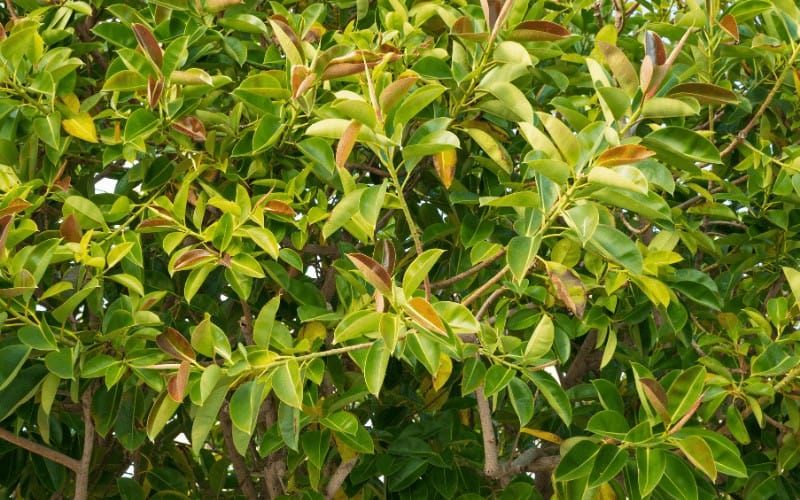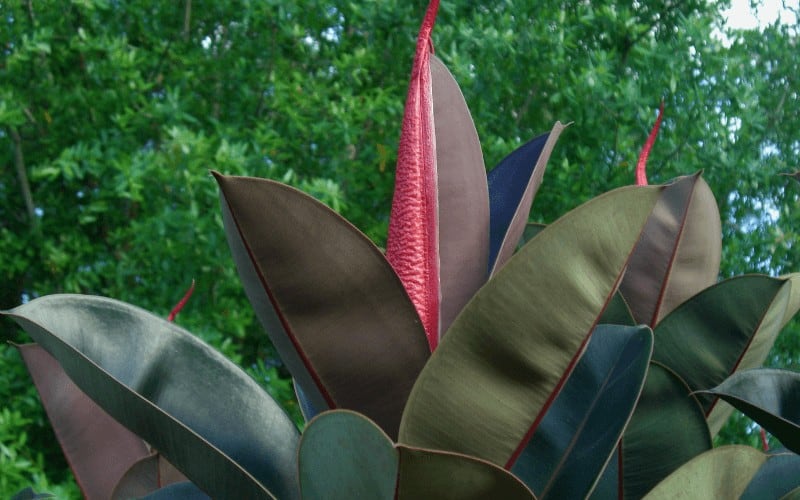Having rubber plant in your house is really worth it, but what happens when it start showing signs that are quite threatening? You will panic? Well, you don't have as there are some practical tips on how to save a dying rubber tree plant.
Rubber tree plants are grateful plants to have as they thrive indoors and outdoors and can easily adapt in any soil or condition. Rubber plants (ficus elastica) are one of the plant that mostly thrive indoors and are easy to care for as it requires less of attention.
This plants help in cleaning the air and removing pollutants. It also produces more oxygen than most of the other plants. Rubber plants are highly beneficial to health, they are inexpensive to grow.
In today’s guide, you’ll not only learn the signs of a dying rubber tree plant, but you will also learn why your rubber plant is dying and how to restore its health.
Table of Contents
Signs Of a Dying Rubber Tree Plant
Rubber plants would not be so appealing when showing some signs that are quite troubling nonetheless. You do not have to panic, you must understand the signs and reasons for their sudden change.
- Leaves turning yellow or black spots appearing on leaves
- Soils having a foul odor
- Leaves falling off
- Dry leaves and droopy leaves
- Pest infestation
- Root rot
- Soft and brown roots
- Leaves wilting and shedding
- Slow growth
- Unattractive leaves
Your plant showing these signs indicates it is on the verge of damaging, if not completely. You still cannot place your head as to what brought about the signs.
Let’s see why your rubber plant would show these signs.
Why Your Rubber Plant Is Dying

1. Watering issues
Watering the plant is good, but over watering your rubber tree plant or not watering it enough brings about some damages that you might not know.
Your plants would show signs of:
- Root rot
- Pest infestation
- Leave turning yellow and droop
- Brown tips on edges of the leaves
- Soil damps
Not watering your plant enough would cause your plant to have these signs;
- Lifeless leaves
- Soils drying out
- Faded leaves
- Slow growth
Note: the primary cause of droopy leaves in the rubber plant would either be overwatering or underwatering, wilting leaves are usually because of overwatering.
2. Lighting issues
Most plants love light, but direct light is never advisable and your rubber plant is no exception. Direct sunlight can cause damage and leaf burns. Not exposing your plant to enough indirect light harms the plant too.
While too much light would leave your plant leaves droopy and burning, low light would let the leaves turn brown and still droop. The stalks become very thin and long.
3. Temperature
Plants wither when they are exposed to harsh weather; cold or hot, allowing your rubber plant go beyond 80 degrees Fahrenheit would bring damages to your plant.
4. Soil mixture
Rubber plants do great in all the soil, but be careful leaving it in clayey or sandy soil.
5. Pest infestation
This is also one of the major reasons for your plant dying. Rubber plants are susceptible to many kinds of pests such as; spider mites, scale insects, mealybugs, thrips.
Having speckled leaves? Unattractive leaves and leaves falling off? It is because of these pests.
6. Root rot
Yes, this might be one sign of a dying rubber tree plant, it is mainly because of over watering, and there are signs your plant would show that shows root rot.
- Stunted growth
- Yellow leaves
- Soft and brown roots
- Mushy roots
- Wilting leaves
- Slow growth
- Severe damages to the root.
These signs and more are reasons behind your rubber tree plant dying and it might prompt you to ask, can you save your dying rubber plant? At least.
How To Save a Dying Rubber Tree Plant

Rubber plants are quite forgiving and easy to grow, so yes! You can save your dying rubber plant.
Note: this is if your plant is not affected completely.
Now, let's look at how to save a dying rubber tree plant:
1. Proper watering
Having known that watering could amount to your plant dying, you might wonder; how much water your plant needs or how often do you need to water your rubber plant?
Your rubber plant needs a lot of water, you must drain the soil with enough water since the plant consumes a lot of nutrients from the soil.
You need to water your plant every 4-5 days, although a rubber plant can go without water for 7days, if only you plant has enough water to keep it going.
Note: The water needs of the plant would depend on its size, the smaller it is, the more water it needs, the bigger it is the less frequent water it needs.
Further tips on watering
- If you have over watered the plants, stop watering it for some time until the soil dries up to 1 inch.
- Cut the damaged leaves
- Let your plant receive good ventilation
- If you have not watered the plant enough, consider watering it 4-5 days, make sure not to drown it!
- Remember to give your plant water at room temperature only, in other words cold or hot water is not advisable.
2. Lighting
Try as much as possible to keep your rubber plant away from direct sunlight.
- Find a spot where it gets early morning sun and late afternoon sun.
- If you already exposed it to too much light, find some shade or consider not exposing to direct light at all
- Provide shade, if the plant is kept outdoors.
3. Temperature
Though your plant would thrive in various temperatures, it should be more comfortable with the range between 60-8p degrees Fahrenheit (15-28 degrees Centigrade).
Howbeit the need to water would vary because of temperature Changes. Water less frequently when the temperature falls below 65 degrees Fahrenheit.
4. Soil mixture
Your plant might survive in any given soil, but doesn’t its ideal growth, you can mix loam soil, peat and coarse sand. Feed you would well and watch your plant grow well.
5. Pest infestation
You want to ensure your rubber plant is well protected from insects and pests. You can fight pests by:
- Using insecticides to stave them off
- Spraying been oil
- Trying to print the affected area, if you want your plant to live!
- You can try mixing a teaspoon of neem oil and a teaspoon of a mild dish with 1 liter of water and spray all over the plant
- Isolate the plant from other plants for the rest of the time you are treating it.
- You can spray isopropyl alcohol.
6. Root rot
Try checking for the said signs, and treat your plant immediately you discover any sign
- Chop and remove dark, brown, and mushy leaves.
- Remove all the soil so that any chance of mold resuming its state is completely lost.
- Let the weak root fall off
- You can clean the roots of the plant under running water.
- Prune the affected area and let it dry naturally after cleaning it. Do this for at least 24 hours.
- If you use pot, you can consider repotting with terracotta pot, make sure it has good drainage.
- Add some good fertilizer to enhance the growth.
- While watering the plant do not drown it less it brings about root rot again!
Conclusion
Saving your dying rubber tree plant should be a walk in the park if you follow these procedures. Be sure to know the signs as stated above before administering any control measure.
Please remember to not over care for your plant, be nice to your plant and whilst letting grow, still check on it.
Hopefully, you get to save that dying rubber plant now that you know how to save a dying rubber tree plant, have a great experience saving it!




